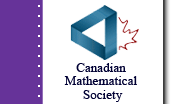April 2017
- Math Central (MC):
-
First of all thank you Laura for agreeing to share with us some of your life as a mathematician.
Can you start by telling us your job title and who is your employer?
- LAURA :
-
My current job title is Biostatistician and my employer is Emmes
- MC:
-
How would you describe your job?
- LAURA
-
I collaborate with clients and project team members to help with clinical trial research. I work on developing systems for monitoring the quality of the data and review protocols and case report forms to ensure that the protocol and study objectives are met and standards are maintained. I work on statistical analysis plans, perform analysis and write reports summarizing findings. This involves generating treatment allocations in randomized clinical trials and ensuring proper assignments are given, writing developing, and validating programs to perform analysis and displaying the study data. I also am required to implement safety monitoring reports to ensure the safety of the clinical trial participants, and to generate study reports that are distributed both internally and externally to the client, monitoring committees and regulatory bodies.
- MC:
Tell us a little about your background and education.
- LAURA:
I was born in Edmonton, Alberta and moved to Victoria, B.C. when I was very young. I did my public education in Victoria and graduated from Mount Douglas Secondary School. After high school, I took a year to volunteer in a remote and self-sufficient community for adults with learning disabilities in Southern England. Upon my return, I attended the University of Victoria where I obtained a Combined Honours in Mathematics and Statistics degree. During this time, I had the opportunity to complete two Natural Sciences and Engineering Research Council of Canada (NSERC) Undergraduate Student Research Awards (USRA) research terms.
After completion of my undergraduate degree, I took 5 months to backpack around Asia before returning to the University of Victoria for a Master’s of Science in Statistics. I wanted to pursue a degree in which I could explore and hopefully impact the field of health using mathematics and statistics. I had two supervisors for my Master’s degree, a statistics professor and a mathematics professor, which allowed me the opportunity to work with an interdisciplinary team including medical researchers from Montreal, Quebec. My thesis (Filtering and clustering GPS time series for lifespace analysis) focused on developing techniques to filter GPS time series data and analyze lifespace.
I was very fortunate to receive various academic awards during my time as a student. Some of these awards include the University of Victoria’s President’s Scholarship (2006), invitation to join the Golden Key International Honours Society (2006), NSERC USRA (2008, 2009), University of Victoria Fellowship (2010), University of Victoria Academic Income Supplement (2011), University of Victoria Graduate Award (2011).
Prior to graduating with my Master’s degree, I received a job offer from PRA Health Sciences, an international contract research organization with an office in Victoria, to work as a clinical programmer in clinical trial research. I worked for PRA Health Sciences for a few years before moving onto another contract research organization, Theorem (who was acquired by Chiltern International) where I proceeded to work as a Statistical Programmer/Analyst from home. I have since moved onto the Emmes Corporation where I currently work as a Biostatistician from home.- MC:
How Do You Use Mathematics in your work?
- LAURA:
My degree in mathematics and the connections that came with it greatly influenced my career choices and is what helped me get into clinical trials originally as a programmer. I later made the switch in roles to a biostatistician as I wanted to be able to utilize both the mathematical and statistical aspects of my degrees.
I believe that a strong foundation in mathematics can help people succeed in many careers even if the connection to mathematics may not be obvious at the surface level as the skills acquired are highly transferrable. Although my current job title may not indicate that mathematics is part of my daily life, it most certainly is. In clinical trials, we are often faced with new challenges where we need to come up with new methods or ideas as to how to deal with certain situations. To produce reports on various aspects of the trial, I program in software which is largely driven by mathematics. A degree in mathematics started my learning in how to program, which has clearly been utilized throughout my career. More importantly, mathematics has taught me to work in a detailed and structure way and to think critically allowing me to solve problems that arise in my work.
- MC:
-
What do you do when you are not doing mathematics? What are your hobbies and other interests.
- LAURA:
-
I like to travel and have made it to over 30 counties so far. I also enjoy participating in activities such as caving, zip-lining, camping, and working out.

